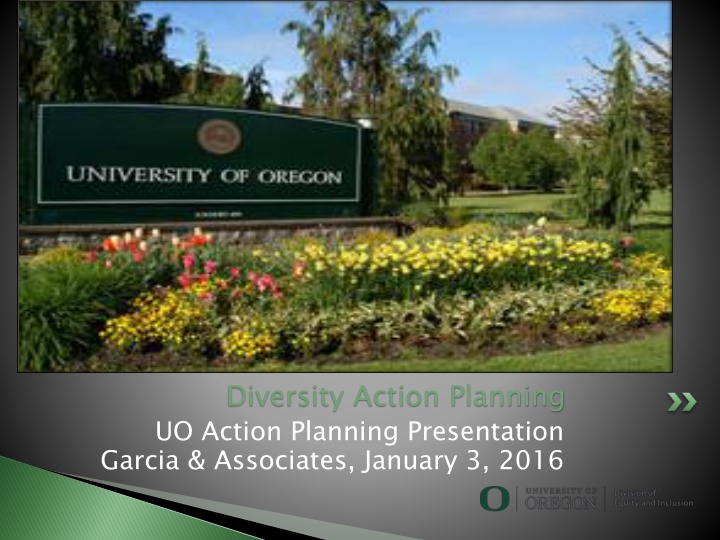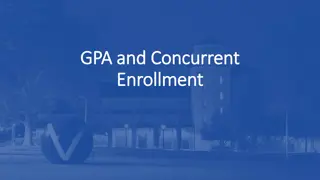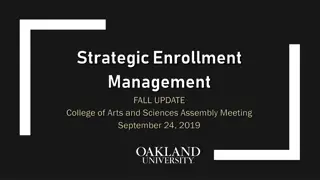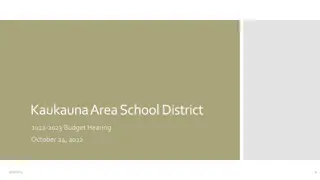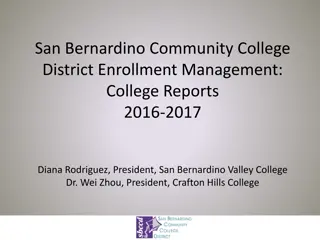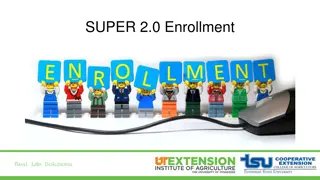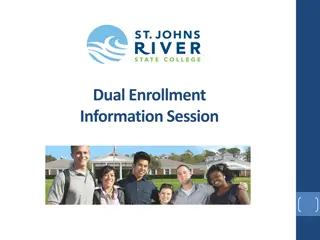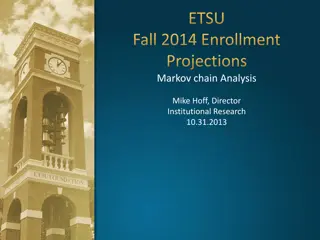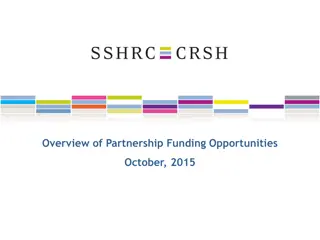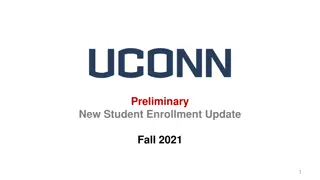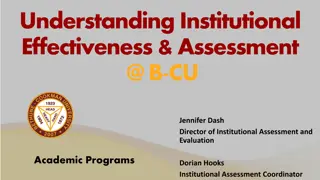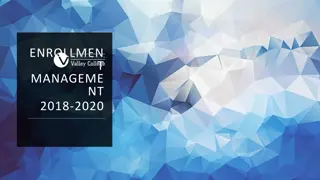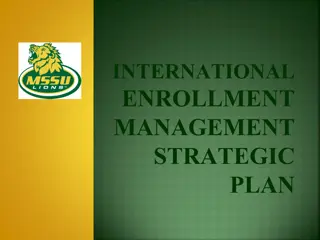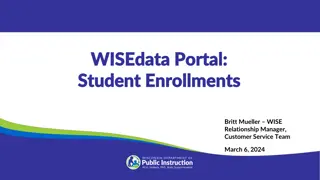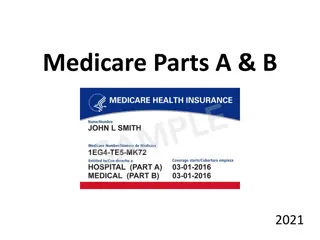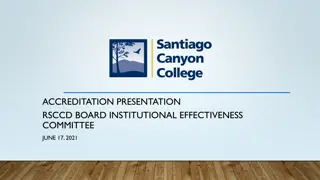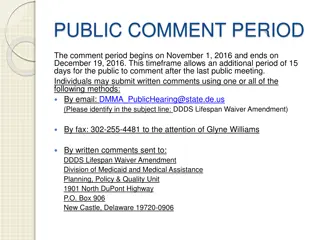Institutional Effectiveness Partnership Initiative and Enrollment Management
This presentation delves into the Institutional Effectiveness Partnership Initiative aimed at enhancing community colleges in California by improving educational programs and outcomes for students. The initiative focuses on eliminating accreditation sanctions, enhancing access and equity, and fostering success. Led by the Chancellor's Office, it involves key components such as a framework of indicators, technical assistance, and professional development opportunities.
Download Presentation

Please find below an Image/Link to download the presentation.
The content on the website is provided AS IS for your information and personal use only. It may not be sold, licensed, or shared on other websites without obtaining consent from the author.If you encounter any issues during the download, it is possible that the publisher has removed the file from their server.
You are allowed to download the files provided on this website for personal or commercial use, subject to the condition that they are used lawfully. All files are the property of their respective owners.
The content on the website is provided AS IS for your information and personal use only. It may not be sold, licensed, or shared on other websites without obtaining consent from the author.
E N D
Presentation Transcript
Diversity Action Planning UO Action Planning Presentation Garcia & Associates, January 3, 2016
GOAL: We, the president, provost, vice provosts, vice presidents, deans and other leadership of the University of Oregon, are committed to creating an inclusive, welcoming, and equitable learning environment for every member of our academic community. Diversity, equity and inclusion are integral parts of each of these objectives. GOAL: STRATEGY: It is our responsibility as a public university to create a learning and research environment that seeks diverse perspectives, demands equity, and fosters inclusion. STRATEGY: -President Michael Schill, April 2016.
This IDEAL Framework Inclusion, Diversity, Evaluation, Achievement, and Leadership. . IDEAL Framework contains five key pillars: Each of the IDEAL pillars provides relevant strategies and initiatives to effectuate them in your planning. The IDEAL Framework is meant to guide decisions, healthy debates, resource allocations and actions across the entire university. Each of these outcomes require various strategies and goals to begin, enhance, and sustain the work of diversity, equity and inclusion. Metrics and articulation of success are also to be embedded in unit s action plans.
Mission Vision Values Frameworks: President s Priorities & IDEAL UO Diversity Action Plan Template Data Stats, Trends, and Other Data Points Evaluation: Benchmarking and Metrics SWOT Analysis Resources available the Division of Equity & Inclusion (DEI) Website
Templates and other Supporting Documents Understand Organizational Structure & Process Understand Culture & Climate at UO Identify Potential Partners (Internal/External) Community Ties (Local, National, International) Resources (FTE, Budget, In Kind, Collaborations) Persuasion and communication Execute, modify, or adjust Don t get discouraged: look at your gains and big picture Celebrate your wins Journey not a destination
Purpose: research university committed to exceptional teaching, discovery, and service. We work at a human scale to generate big ideas. As a community of scholars, we help individuals question critically, think logically, reason effectively, communicate clearly, act creatively, and live ethically. Purpose: The University of Oregon is a comprehensive public Vision: research university encompassing the humanities and arts, the natural and social sciences, and the professions. We seek to enrich the human condition through collaboration, teaching, mentoring, scholarship, experiential learning, creative inquiry, scientific discovery, outreach, and public service Vision: We aspire to be a preeminent and innovative public
Values: success of the students, faculty, and staff who work and learn here. We value academic freedom, creative expression, and intellectual discourse. We value our diversity and seek to foster equity and inclusion in a welcoming, safe, and respectful community. We value the unique geography, history and culture of Oregon that shapes our identity and spirit. We value our shared charge to steward resources sustainably and responsibly We value the unique geography, history and culture of Oregon that shapes our identity and spirit. Values: We value the passions, aspirations, individuality, and
At UO, we embrace the full spectrum of diversity, including age, color, culture, disability, ethnicity, national origin, race, religion, sex, sexual orientation, and socioeconomic status. We have aspirations to increase inclusion and representation of historical underrepresented groups to meet our mission, vision, and values. Embracing and building a community of inclusion means we honor, respect, embrace and value the unique contributions and perspectives of students, faculty, staff, alumni and community members. Diversity is fundamental to creating a positive, equitable, and inclusive environment in which they can live, work, learn, and teach. The University of Oregon aspires to be a welcoming, supportive and respectful community for people diverse in culture, identity, thought, perspective, and interests.
Presidents Priorities IDEAL Framework Building its academic and research profile The IDEAL Framework contains five key pillars: Ensuring student access and success Inclusion Diversity Evaluation Achievement Leadership Offering a rich, diverse, and high-caliber educational experience Diversity, equity and inclusion are integral parts of each of the above objectives.
Action desired future. In this case, the Action Planning for Diversity, Equity, and Inclusion (APDEI) is a road map to lead your planning and outcomes. Your plan should be aligned President s Priorities and IDEAL. Action planning is planning is a tool for organizing a tool for organizing for our The purpose of action planning is to align with the UO s mission, values, priorities, and framework to support the identified goals should be practical, prioritize greatest needs, implement, guide, evaluate, and adjust for initiatives, programs, policies, practices, and activities. to align with the UO s mission, values, priorities, and framework to support the identified goals and and tactics tactics. Your APDEI
The action planning document has a basic overall framework. Place all parts of a plan into the following three areas, you can clearly see how the pieces of your plan can fit together: Where are we strategic position and clarify your unit s mission, vision, and values. Where are we now? ( now? (Executive Summary) Review your current Where are we going? unit s vision by using the President s Priorities & IDEAL Framework. Where are we going? (Tactics and Measures) Establish your How will we get there resources to connect where you are now to where you re going. Review institutional strategic objectives, goals, data points, action items, timelines, resources, etc. How will we get there? ( ? (Resources) ) Understand the available
Ignoring includes research and analysis. Take it seriously. Use it to move forward. Ignoring what your planning process reveals: what your planning process reveals: The planning process Being takes time and effort. Be realistic and schedule planning sessions. Work backwards on your timeline. Plans due March 17, 2017. Being unrealistic about your ability to unrealistic about your ability to plan: plan: Putting together a plan Not stakeholders to ensure representation of different perspectives. The action planning process must engage individuals and team members to work together. Not a one person planning a one person planning process: process: Planning must engage various Not a one person implementation process: must involve various stakeholders to implement the plan within the unit. Identify as many multiple responsible parties. Not a one person implementation process: Execution of the plan Need support or more direction? Reach out ASAP the last minute. Action planning takes time. Need support or more direction? Reach out ASAP. Don t wait until
Tactics: S Specific. What will it accomplish? How and why will it be accomplished? M Measurable. How will you measure whether or not the tactic has been achieved (list at least two indicators)? A Achievable. Is it possible? Have others done it successfully? Do you have the necessary knowledge, skills, abilities, and resources to accomplish it? Will meeting the tactic challenge you without defeating you? R Results-focused. What is the reason, purpose, or benefit of accomplishing it? What is the result (not activities leading up to the result) of the tactic? T Time-bound. What is the established completion date and does that completion date create a practical sense of urgency?
Tactics Tactics Metrics Metrics S S Specific Specific Is Is the result or outcome clearly stated? Can the result be measured? Can the tactic be achieved? Does the tactic link to the strategy of the IDEAL framework? Is the completion time of the tactic clearly identified? the result or outcome clearly stated? Is the metric clear, easy to understand? Is the metric clear, easy to understand? M Measurable Are the data readily available? Can you influence a change in the result? Does the metric measure what is important? How often do you need the data? A Actionable R Relevant T Timely
Develop and implement diversity and inclusion benchmarks to ensure responsibility and accountability. Benchmarking is the process of comparing the progress of one s organization to a determined measure. In order to appropriately assess UO s progress, three types of benchmarking can be utilized: 1. Benchmarking against ourselves 2. Benchmarking against peer and notable institutions 3. Benchmarking against accepted standards Reference: Reference: Global Diversity & Inclusion Benchmarks: Standards for Organizations Around World by O Mara and Richter.
The UO seeks to incorporate unbiased evaluations of the implementation of strategies and initiatives employed to meet institutional goals relating to diversity, equity and inclusion. The UO seeks to establish key metrics and reporting structures necessary to ensure accountability and an inclusive process of review. Evaluation can be based on different types of evaluation processes. Selected Examples: 1. Process Evaluation Program Operation (Assess program and activities.) 2. Outcome Evaluation- Program Achievement (Focus on outputs and outcomes to judge program effectiveness.) 3. Impact Evaluation- Form of outcome evaluation that assesses the net effect of program by comparing program outcomes. 4. Cost-Benefit and Cost Effectiveness Analyses Compare a program s outputs and outcomes with the costs (resources expended) to provide them.
Review Prior to Action Planning: AAEO Placement Goals Hiring Trends Student Admission Trends Retention Trends for Staff, Faculty, and Students Existing Reports & Surveys Budget Review for Diversity Policies and Practices for Diversity Other data?
